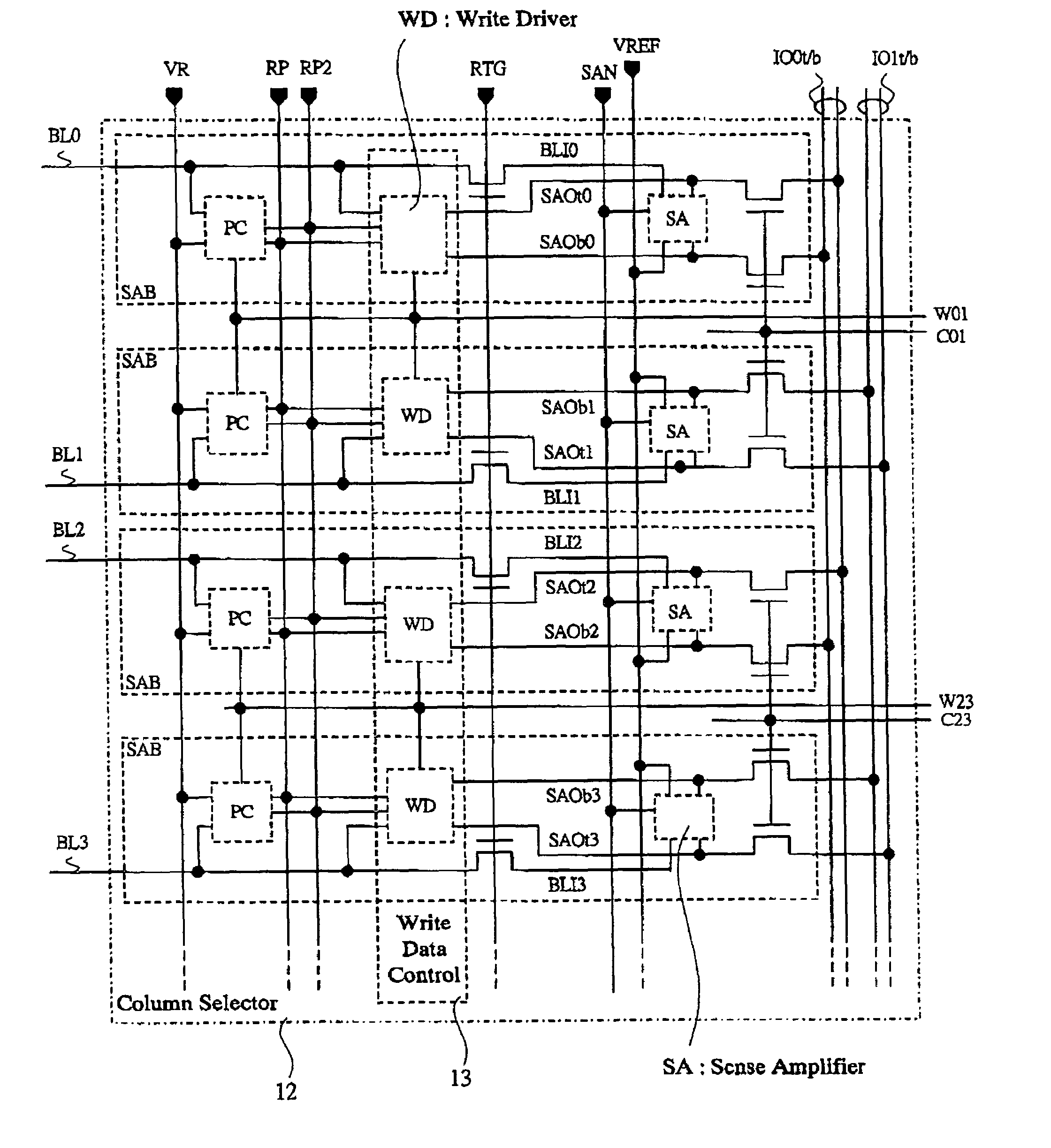Semiconductor integrated circuit device
a technology of integrated circuits and semiconductors, applied in information storage, static storage, digital storage, etc., can solve the problems of ensuring a write time and the inability to solve the drawbacks of phase-change memory operation, and achieve stable operation, short operation cycle time, and high-integration and high-speed nonvolatile memory
- Summary
- Abstract
- Description
- Claims
- Application Information
AI Technical Summary
Benefits of technology
Problems solved by technology
Method used
Image
Examples
first embodiment
[0050]FIG. 1 is a block diagram of a nonvolatile memory according to a first embodiment of the present invention; FIG. 2 is a circuit diagram showing a configuration example of a memory cell array provided in the nonvolatile memory in FIG. 1; FIG. 3 is a block diagram of a memory cell provided in the memory cell array in FIG. 2; FIG. 4 is a circuit diagram of a column selector provided in the nonvolatile memory in FIG. 1; FIG. 5 is a circuit diagram showing one example of a pre-charge circuit provided in the column selector in FIG. 4; FIG. 6 is a circuit diagram showing one example of a sense amplifier provided in the column selector in FIG. 4; FIG. 7 is a circuit diagram showing one example of a write driver provided in the column selector in FIG. 4; FIG. 8 is a timing chart of a write operation in the nonvolatile memory in FIG. 1; FIG. 9 is a timing chart of a read operation in the nonvolatile memory in FIG. 1; FIG. 10 is a timing chart showing another example of a write operation...
second embodiment
[0151]FIG. 12 is a circuit diagram of a column selector provided in a nonvolatile memory according to a second embodiment of the present invention; FIG. 13 is a circuit diagram of a write driver provided in the column selector of FIG. 12; FIG. 14 is a timing chart showing one example of a write operation by a nonvolatile memory according to a second embodiment of the present invention; and FIG. 15 is a timing chart showing another example of a write operation by a nonvolatile memory according to a second embodiment of the present invention.
[0152]In the second embodiment, the nonvolatile memory has the same configuration as that of the above-described first embodiment, but is different therefrom in a circuit configuration of a column selector 12a.
[0153]FIG. 12 is a circuit diagram showing a portion of the column selector 12a.
[0154]A column selector 12a simultaneously performs processes for changes to low-resistance and high-resistance states per column cycle in the same period.
[015...
third embodiment
[0187]FIG. 16 is a circuit diagram of a column selector provided in a nonvolatile memory according to a third embodiment of the present invention; FIG. 17 is a circuit diagram of a write driver provided in the column selector of FIG. 16; FIG. 18 is a timing chart showing one example of a write operation by a nonvolatile memory according to a third embodiment of the present invention; FIG. 19 is a circuit diagram showing another example of the column selector of FIG. 16; FIG. 20 is a block diagram showing one example of a nonvolatile memory having a refresh operation function, which is a third embodiment of the present invention; FIG. 21 is a circuit diagram showing one example of a memory cell in the nonvolatile memory in FIG. 20; FIG. 22 is a block diagram showing one example of a nonvolatile memory having a data correcting function, which is a third embodiment of the present invention; and FIG. 23 is a circuit diagram showing one example of a memory cell array in the nonvolatile m...
PUM
 Login to View More
Login to View More Abstract
Description
Claims
Application Information
 Login to View More
Login to View More - R&D
- Intellectual Property
- Life Sciences
- Materials
- Tech Scout
- Unparalleled Data Quality
- Higher Quality Content
- 60% Fewer Hallucinations
Browse by: Latest US Patents, China's latest patents, Technical Efficacy Thesaurus, Application Domain, Technology Topic, Popular Technical Reports.
© 2025 PatSnap. All rights reserved.Legal|Privacy policy|Modern Slavery Act Transparency Statement|Sitemap|About US| Contact US: help@patsnap.com



